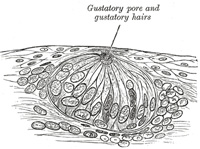| THE ORGANS of the senses may be divided into (a) those of the special senses of taste, smell, sight, and hearing, and (b) those associated with the general sensations of heat, cold, pain, pressure, etc. | 1 |
| |
| 1. The Peripheral Organs of the Special Senses |
| |
| |
| a. The Organs of Taste— (Organon Gustus)
The peripheral gustatory or taste organs consist of certain modified epithelial cells arranged in flask-shaped groups termed gustatory calyculi (taste-buds), which are found on the tongue and adjacent parts. They occupy nests in the stratified epithelium, and are present in large numbers on the sides of the papillæ vallatæ (Fig. 850), and to a less extent on their opposed walls. They are also found on the fungiform papillæ over the back part and sides of the tongue, and in the general epithelial covering of the same areas. They are very plentiful over the fimbriæ linguæ, and are also present on the under surface of the soft palate, and on the posterior surface of the epiglottis. | 2 |
 |
FIG. 850– Vertical section of papilla foliata of the rabbit, crossing the folia. (Ranvier.) (See enlarged image) |
| |
| |
| Structure.—Each taste bud is flask-like in shape (Fig. 851), its broad base resting on the corium, and its neck opening by an orifice, the gustatory pore, between the cells of the epithelium. The bud is formed by two kinds of cells: supporting cells and gustatory cells. The supporting cells are mostly arranged like the staves of a cask, and form an outer envelope for the bud. Some, however, are found in the interior of the bud between the gustatory cells. The gustatory cells occupy the central portion of the bud; they are spindle-shaped, and each possesses a large spherical nucleus near the middle of the cell. The peripheral end of the cell terminates at the gustatory pore in a fine hair-like filament, the gustatory hair. The central process passes toward the deep extremity of the bud, and there ends in single or bifurcated varicosities. The nerve fibrils after losing their medullary sheaths enter the taste bud, and end in fine extremities between the gustatory cells; other nerve fibrils ramify between the supporting cells and terminate in fine extremities; these, however, are believed to be nerves of ordinary sensation and not gustatory. | 3 |
 |
FIG. 851– Taste-bud, highly magnified. (See enlarged image) |
| |
| |
| Nerves of Taste.—The chorda tympani nerve, derived from the sensory root of the facial, is the nerve of taste for the anterior two-thirds of the tongue; the nerve for the posterior third is the glossopharyngeal. | 4 |

